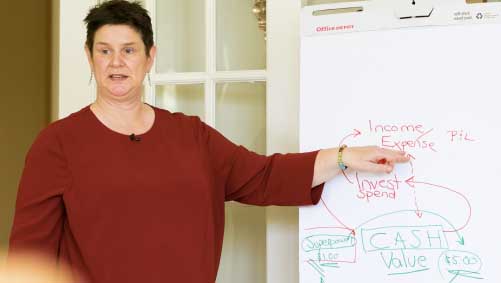
I’m the CFO that 6- and 7-figure entrepreneurs call when they want to get to the next level in their businesses; and I help them get there by focusing on cash flow. By that, I mean providing clear visibility into the next weeks and months of their bank balances so that business owners can make intelligent decisions right now.
One of the ways I do this is by looking at something that is not really all that intuitive because business owners often spend their “finance time” looking at the Profit and Loss Statement (aka the Income Statement) if they are looking at anything at all on a monthly basis.
Quick question: Did you know that your bank balance could actually be going down month after month, even if your Profit and Loss Statement has been showing a profit?
Well, it can, and often does. Sometimes for the right reasons, and sometimes for the wrong reasons. I don’t want it to ever surprise you, but I definitely don’t want it to surprise you all at once at the end of the year when you may have some annual bills to pay (can anyone say “Taxes”?).
Being 100% clear that profit and cash are not the same thing is one of your top priorities as a business owner – and when cash is tight, it is the highest priority.
Let’s break this down:
Most business owners that have moved past the receipts in a shoe box looking somewhat regularly at a monthly or quarterly Profit and Loss Statement.
Some business owners even look at their Balance Sheets as well (even though there’s rarely a good set of information about what it all means).
But – very few businesses get the most important report of all: The Cash Flow Statement.
This statement holds the keys to the kingdom. It is a report that can have a bottom line that’s going in exactly the opposite direction of your profits! And, fortunately or unfortunately, it also represents a very key resource: your bank balance.
So how can profits be going up and up every month, but cash balances go down, down, down?
Let’s take it in steps:
First of all – the only way to know if you even have this issue is to be sure you get the Cash Flow Statement every month and know what it means: It means “This is your bank account balance and what is happening to it.” It tells you about every single dollar coming into or leaving your bank account.
When you take a look at it for the first time, you’ll see that…
…profit is only one of the things that moves that needle.
Dig in to this report and ask your accountant or bookkeeper what each number on the Cash Flow Statement means to your bank account balance.
What you’re going to learn is that there are a few things you can do to fix this “profit up; cash down” paradox. Here is a sample:
- Look at how quickly you’re paying your vendors. Don’t pay your bills until they are due. Maybe even use your credit cards to delay the cash leaving your bank account even further.
- Look closely at how quickly you’re collecting money from your customers. Get after them if they’re not paying you in a timely manner. Or change your payment terms with them (or with future customers). Or look in to getting a loan against what they owe you.
- If you have inventory, be sure you need it. Inventory that sits on your floor or shelves is just like having cash sitting in a jar. Do something with the inventory…mark it for sale, bundle it with other products that sell all the time. Even if you get less than you paid for it originally, if it’s not getting sold or used, It will still put cash in your pocket – so think creatively about turning it into cash.
I recently worked with an amazingly profitable business. The business owner called me when she couldn’t understand how she had a tax bill to pay in 2017 when her bank balance had actually decreased throughout the year.
One look at her cash flow statement explained it. (And would have given her a heads up much earlier if this was a report that her bookkeeper had been providing to her).
Now we are addressing each of the “cash hogs” listed above. Ironically, (or maybe not), each and every one of those things that we’re investigating is actually reflecting a broken business process. So the really good news here is that not only are we solving the cash flow mystery, but we are also fixing chronic problems within the business.
After three months, the trend has shifted, and cash flow is following profitability, thankfully going up. But that’s not to say we won’t intentionally set them going in different directions again. Remember I mentioned that there are good and bad reasons for this phenomenon? There are some really good reasons for this to happen. We’ll save that for another blog post – but remember one word: GROWTH.
So, ask for your Cash Flow Statement, and get your accountant or bookkeeper to tell you exactly what each number on it means. There is actual cash sitting on that report that you can pull into your business in rough times.

Author, Virtual CFO, and Finance Coach
“Your First CFO: The Accounting Cure for Small Business
Owners” on ,AMAZON





